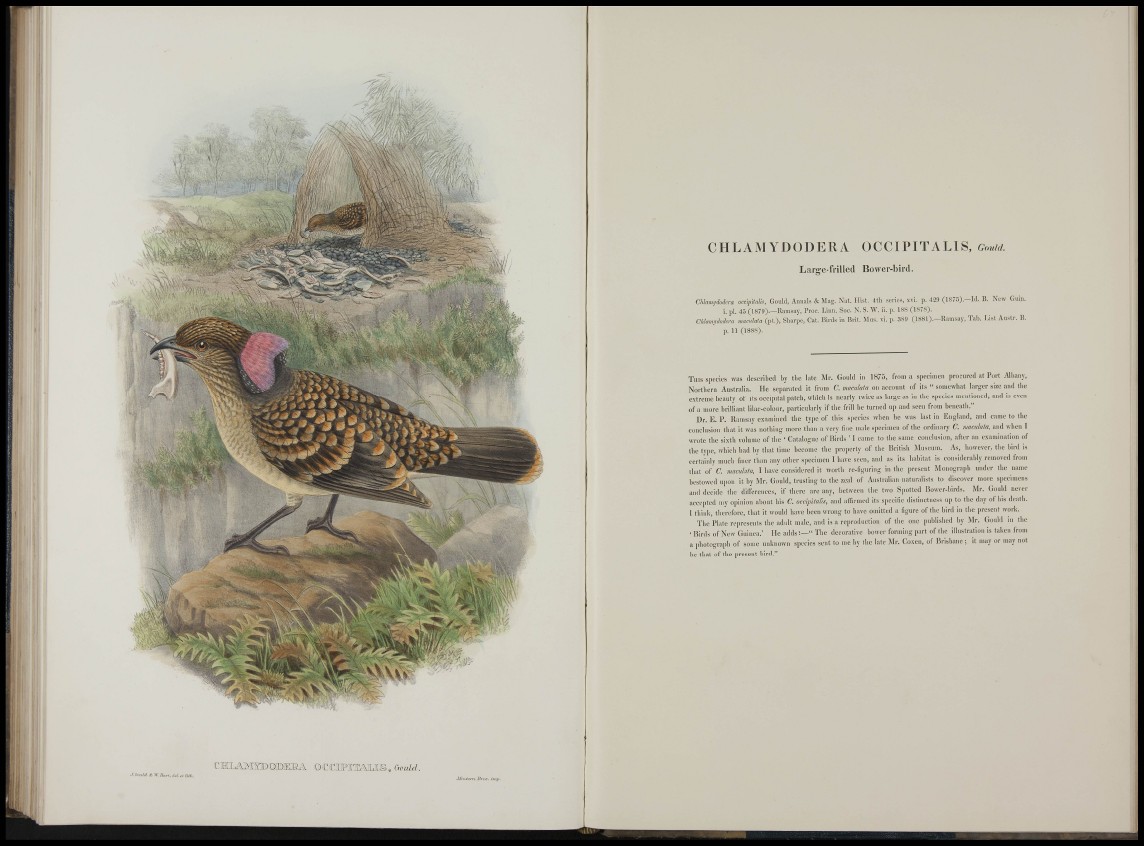
•Mi
li
r'i
M
„ 1
.li
J. Ornici ^ iy.tìoit.cUi.fJ IM ,
Cm^OISlDOIDraA Cwuld.
.VìriicnL ^fcs. imp.
CHLAiMYDODERA OCCIPITALIS, cmi.
L a r g - e - f r i l l e d Bower-bird.
Chìanujiodera occipitalis, Gould, Annals & Mag. Nat. Hist. 4th series, xvi. p. 423 (1875) . - Id. ]i. New Guin.
i. pi. 45 (1879).—Ramsay, Pi oe. Linn. Soc. N. S. W . ii. p. 188 (1S78).
Ghkmydoda-a maculata (pt.), Sharpe, Cat. Birds in Brit. Mas. yi. p. 380 (1881).—Ramsay, Tab. List Austr. B.
p. 11 (1888).
THIS species was descriljed by tlie late Mr. Gould in 1875, from a specimen procured iit Port Albany,
N o r t h e r n Australia. He separated it from C. maculata on account of its " somewhat larger size and the
extreme beauty of its occipital patch, wbicli is nearly twice as large as in the species nienlioued, and is even
of a more brilliant lilae-colonr, particularly if the frill be turned uj) and seen from beueath."
D r . E. P. Ramsay examined the tyjie of this species wlieu he was last in Ensland, aiid came to tlie
conclusion that it was nothing more than a very fine male specimen of the ordinary C. maculata. and when I
wrote the sixth volume of the ' Catalogue of Birds ' 1 came to the same conclusion, after an examination of
t h e type, which had by that time become the property of the British Museum. As, however, the bird is
certainly much finer tiian any other specimen I have seen, and as its habitat is considerably removed from
that of C. maculata, I have considered it worth re-iignriug in the present Monograpli under the name
bestowed upon it by i\Ir. Gould, trusting to the zeal of Australian naturalists to discover more specimens
and decide the dillerences, if there are any, between the two Spotted Bo^ve]•-blrds. Mr. (ioidd never
accepted my opinion about bis C. occii>Ualk, and affirmed its specific distinctness np to tlie day of his death.
I think, therefore, that it would have been wrong to have omitted a figure of tlie bird iii the present work.
T h e Plate represents the adult male, and is a reproiluetion of the one published by Mr. Gould in the
' Bi rds of New Guinea.' He adds " The decorative bower forming part of the illustration is taken from
a ,ihotograi)h of some unknown species sent to me by the late Mr. Coxen, of Brisbane ; it may or may not
be that of the present bird."
B